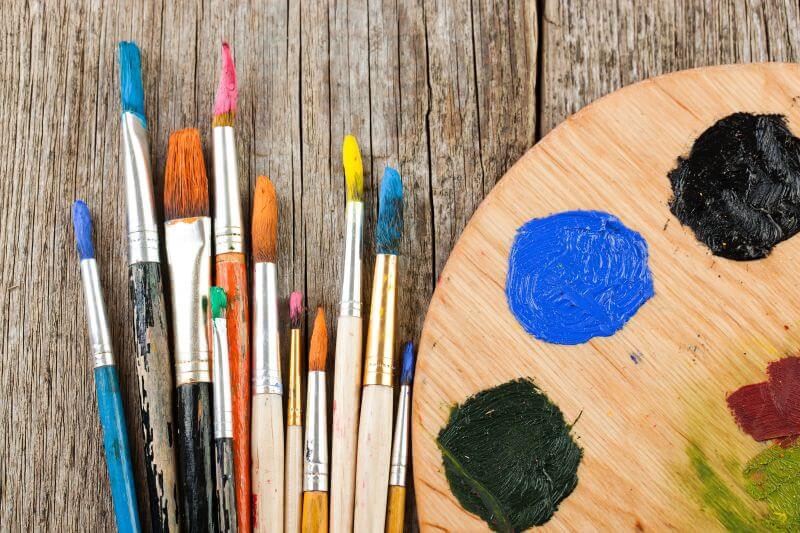
How to choose the right brush
Choosing the right brush is something that will help determine the quality of your artwork. Nothing should get in the way of the ability to smoothly combine inspiration and the honing of technical skills – things that need to work in tandem to help create masterpieces – least of all a badly chosen brush.
THE STRUCTURE OF AN ARTIST PAINT BRUSH
The artist paint brushes used for oil painting consist of the ferrule, the handle and the bristles. The ideal material for the handle is a hardwood from one of the deciduous species of tree. A particularly suitable type of wood is beech, which has a very low water uptake. This means that the wood keeps its shape, and a good connection between the handle and the ferrule can be maintained.
The ferrule on a high-quality brush must be free of welds or joints, made of copper or brass and fit snugly around the handle, so that there are no air-pockets between the two. The bristles are the working part of the brush and, it’s fair to say, the most important part, for it is based on the bristles that an artist selects the right brush for any given painting. They may be made of natural materials or synthetic fibres, and they come in various shapes and sizes.

HOW TO CHOOSE A BRUSH DEPENDING ON THE MATERIAL
Brushes made with natural bristles
These are the most common brushes and the ones most often used by artists. They are made of hog’s hair and are considered to be among the best kinds of brush for oil painting. Natural bristles pick up the paint very well and apply the load to the canvas well. Making a brush with natural bristles is a fairly complicated procedure. The bristles are boiled and bleached and then any split ends are removed.
Kolinsky sable-hair brushes
A kolinsky is a small carnivorous animal, similar to a ferret. These brushes, like those made of hog’s hair, are natural paintbrushes and are commonly used to create watercolours and oil paintings. Sable-hair brushes are usually used by artists who like to paint in thin, translucent layers. Sable-hair brushes provide soft, subtle strokes, making them ideally suited for portrait-painting and for all the fine detail in a painting. Artist brushes made of sable-hair will last a long time, if you use a fine-grained canvas. When using a medium-grained canvas, meanwhile, you’ll find you can wipe off any stray bristles from the brush more quickly. Natural sable-hair brushes are also suitable for the ‘drybrush’ painting technique.
Synthetic brushes
One hears various things said about synthetic brushes for oil painting, and the feedback about them is mixed. With the emergence of good-quality brushes made with synthetic fibres, however, novice painters are increasingly shunning brushes with natural bristles. Good synthetic brushes can sometimes be on a par with natural brushes. Synthetic brushes are now available with varying degrees of bristle thickness, enabling artists to choose their brush depending on the task at hand. Thick synthetic bristles are suitable for doing the undercoat and for the fast alla prima painting technique (as are brushes made of natural bristles). Thin synthetic bristles, on the other hand, are similar to natural sable-hair brushes. They can be used to paint paintings consisting of lots of thin layers. By comparison with brushes made of hog’s hair and sable-hair, synthetic brushes have both upsides and downsides. The bristles don’t fall out of them. They are easier to look after (thinning agents, diluents and linseed oil all affect natural brushes in different ways). They last longer and are suitable for any canvas, however finely or coarsely grained. Some brushes made with synthetic fibres may lose their shape over time and become bushy. There are loads of suggestions to be found on the Internet, though, about how to solve this problem and get the brush back to its original shape.
Squirrel-hair brushes
These brushes are not used in oil painting, or at least not widely used. Some artists use these brushes to lend a light tint to the paint. This is purely a matter of personal preference and habit, though. Squirrel-hair brushes are perfect for painting with watercolours, but when used with oil they quickly become unfit for use. Paintbrushes are among the most important tools of all in an artist’s hands. But an even more important factor is whether the artist knows how to use them and look after them.

HOW TO CHOOSE A BRUSH DEPENDING ON THE SHAPE
The styles of brush tip seen most commonly are:
- Round: pointed tip, long closely arranged bristles for detail.
- Flat: for spreading paint quickly and evenly over a surface. They will have longer hairs than their Bright counterpart.
- Bright: shorter than flats. Flat brushes with short stiff bristles, good for driving paint into the weave of a canvas in thinner paint applications, as well as thicker painting styles like impasto work.
- Filbert: flat brushes with domed ends. They allow good coverage and the ability to perform some detail work.
- Fan: for blending broad areas of paint.
- Angle: like the filbert, these are versatile and can be applied in both general painting application as well as some detail work.
- Mop: a larger format brush with a rounded edge for broad soft paint application as well as for getting thinner glazes over existing drying layers of paint without damaging lower layers.
- Rigger: round brushes with longish hairs, traditionally used for painting the rigging in pictures of ships. They are useful for fine lines and are versatile for both oils and watercolours.





